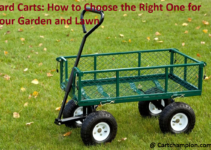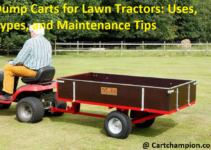Have you been dreading all the yard work that needs to be done? You don’t have to suffer anymore. A garden cart is the perfect solution for all your outdoor chores. You’ll feel like a pro as you effortlessly navigate around the yard with this handy tool.
Ready to get started? Let’s explore how a garden cart can help you make light work of your garden tasks!
Introducing a garden cart to your outdoor toolbox can help you take care of your yard with less strain and frustration. Garden carts make it easier to transport the materials and supplies you need while you’re working, saving time and energy in the process. Plus, these ingenious devices offer extra storage space for landscaping projects such as leaf-blowing or weeding.
If you’re wondering how to choose the right cart for your needs, keep reading for the ultimate guide to garden carts and the features they offer.
Benefits of using a garden cart for yard work
The benefits of using a garden cart to tackle yard work are abundant. Garden carts can help you move heavy pots and other gardening equipment quickly and safely, saving you time and energy. With large wheels, they make it easy to transport soil and mulch in large quantities around the garden, reducing strain on your body as you move heavy items. And for larger spaces, garden carts also make it easier to cover ground as you efficiently move from site to site.
Moreover, with a garden cart you can avoid bending over repeatedly to move smaller items around the yard or carry them over long distances. You can easily store your tools and equipment in the cart itself while working so they are always within reach when needed. A garden cart can also be used to transport materials such as soil and rocks between different worksites in your yard.
Ultimately, utilizing a garden cart can greatly reduce exhaustion caused by manual labor that often comes with gardening tasks. The convenience of having a good rolling cart will not only help streamline your workflow but also make gardening much more enjoyable as a whole!
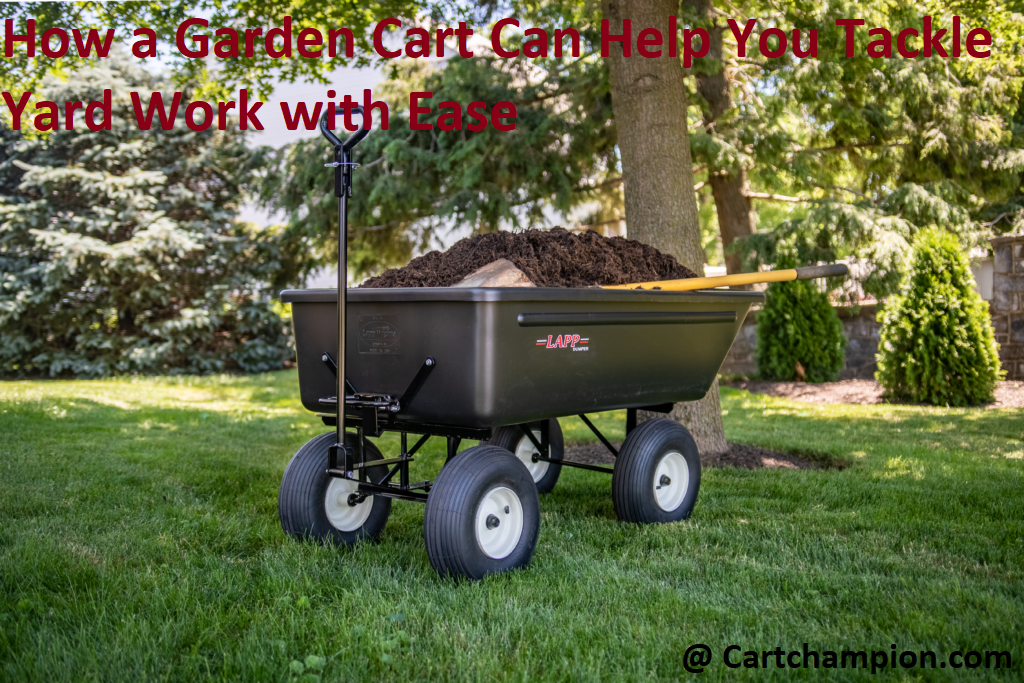
Saves time and energy
Using a garden cart to help with yard work can be a huge time saver and can help conserve energy. By using a garden cart, you will no longer have to make multiple trips carrying heavy loads of soil, mulch, stones or whatever it is you need for your next project. This will save you time and energy in the long run as it allows you to simply fill up the cart with all that you need for the job and transport them to where they need to go in a single trip.
Additionally, carrying heavy loads manually across your yard can take a physical toll on your body. But by having a cart at your disposal, all the hard labor is removed from the equation.
Reduces strain on the body
A garden cart helps reduce strain on the body when doing yard work. The optimal design for a garden cart is lightweight, low profile, maneuverable and with enough capacity to carry large amounts of soil and other materials. It should also have long handles to make it easier to pull or push the heavy loads around your yard or garden.
The main advantage of using a garden cart is that it eliminates the need to lift, bend and move heavy loads by hand. This reduces the risk of strain on your back, arms and shoulders. Additionally, having access to a large inventory of tools in one place prevents you from having to go back and forth fetching them repeatedly – making chores significantly less time consuming.
Increases productivity
A garden cart can significantly increase your productivity when tackling yard work. It allows you to move plants, soil, and other gardening materials with ease. For example, you can fill it with soil to move large amounts of material quickly between gardens or to the compost heap.
You can also fill it with tools such as pruning shears and clippers, which makes it easier to transport them between different sites while avoiding unnecessary trips.
A garden cart is an invaluable tool that helps reduce time and effort expended on laborious tasks around the yard.
III. Features to consider when choosing a garden cart
It is important to research and compare different garden carts in order to find the type that best suits your needs. Consider questions such as: How wide is the bed? What material is it made of? How easy is it to dump and clean? What are the wheels like? The answers to these questions will help you decide which model to purchase. Depending on the size and style of your yard, you may choose a traditional wheeled cart, an all-terrain wagon, or a more versatile folding cart with motorized tires.
Wagons – These heavy-duty carts feature four large wheels that are often filled with air for additional traction and strength over rough terrain. They generally have low sides for easy dumping, but may not have beds deep enough for hauling large volumes of soil or lumber. Wagons are most suitable for larger yards where either speed or weight isn’t an issue.
Wheelbarrows – This style offers greater versatility, allowing you move heavier loads faster and with less effort than a traditional wagon. With one wheel in front and two behind it, wheelbarrows offer much better maneuverability, however they lack capacity when compared to wagons. They can also be tricky to maneuver over rocky terrain due to their lightweight frames.
Folding Carts – Folding garden carts are long-lasting tools made out of strong materials such as polyester or aluminum which make them ideally suited for moving sizeable loads across uneven surfaces like lawns or dirt pathways. These larger options tend to come with pneumatic tires that provide extra cushioning on rougher terrain, as well as convenient side dumps for emptying soil without leaving tracks across the lawn or garden area being worked on.
Motorized Garden Carts – Designed primarily for commercial use and landscapers who frequently need off road access over rough terrain; motorized garden carts use powerful electric motors instead of physical energy from users pushing them along manually. Motorized units allow workers to pull heavier loads at higher speeds more evenly than manual push carts can handle irrespective of surface conditions.
Capacity
In order to determine the capacity of a garden cart, consider what types of items it is likely to be used for. The most common items are plants, soil bags, fertilizer and tools. A garden cart should have enough capacity to allow you to transport enough material for larger tasks or multiple trips when needed.
With a garden cart you can easily move heavier loads like logs, rocks and soil bags while still making sure they remain safe and secure. Many carts are available with removable pans that make it easy to transfer material from one place to another. Garden carts come in different shapes and sizes, so it’s important to measure your yard and the materials you need before purchasing one. Make sure that the garden cart you select is suited for your specific tasks.
You might also consider additional features like water-resistant containers or side walls if your cart will be used for more than just plants and dirt bags. Also make sure that the wheels on your garden cart are able to roll easily across uneven surfaces without getting stuck in puddles or mud. A good quality materials should last years so you can get the most bang for your buck when selecting a garden cart!
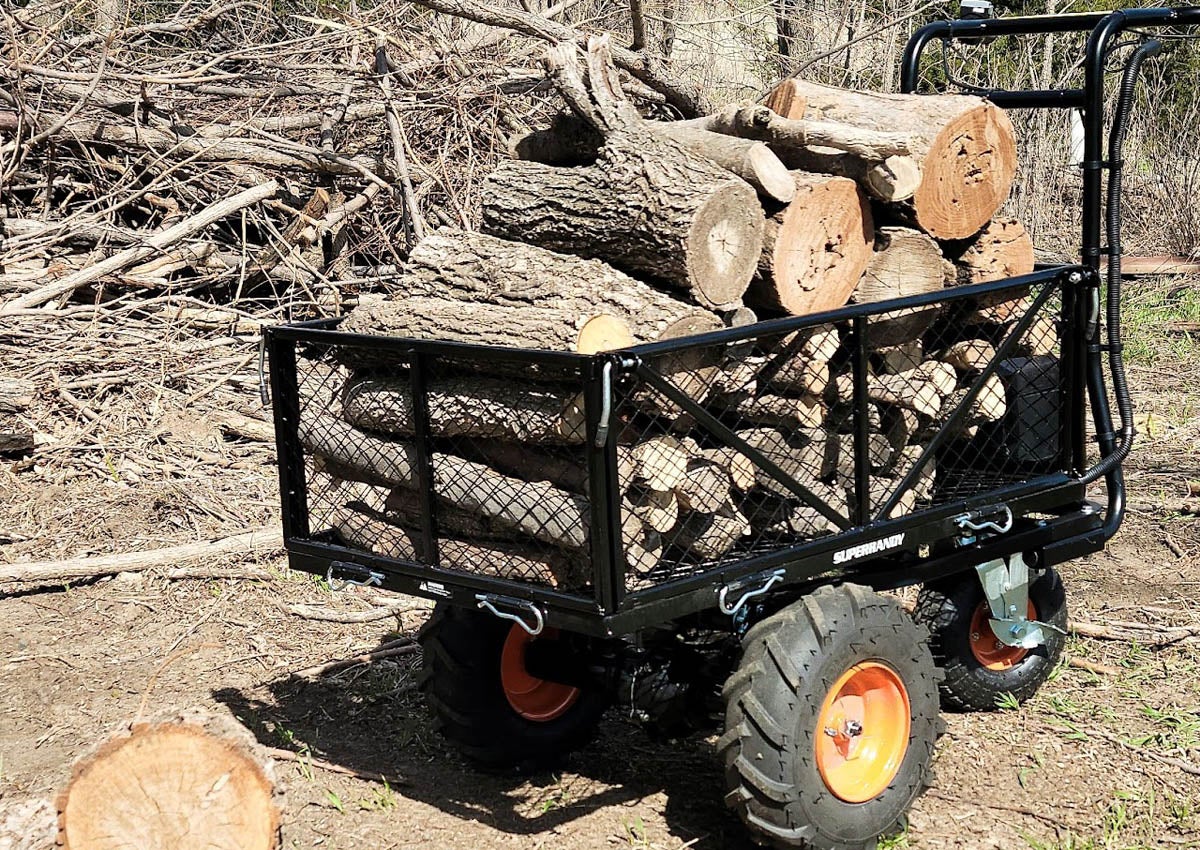
Material
When you’re trying to tackle a big yard project, many people wonder what type of garden cart they should use. It’s important to consider the capacity and material of the cart as it can make a difference in how successful your project is.
Garden carts come in a range of materials from metal, plastic, and wood, depending on the model and manufacturer. One of the most durable materials for garden carts is steel or aluminum for heavy-duty usage like carrying large objects or hauling multiple items. They are designed with reinforced walls and have the strongest axle loading capacity for tough jobs like moving large piles of debris or soil backyards or moving items from your yard to your garage. The steel frames offer more control over bumps and impacts. Steel is also rust-resistant so you won’t have to worry about it getting corroded over time.
Plastic carts are quite versatile as they can be made into any shape that has enough load-carrying capacity and stability. They are slightly lighter in weight which makes them easier to maneuver around corners, but they do not offer much strength when transporting heavy objects over surfaces that may contain obstacles such as stones or tree roots. Plastic carts also tend to wear out more quickly than their metal counterparts and may not be suitable for more strenuous jobs like hauling rock filled wheelbarrows of dirt up and down hillsides.
Wood can be either hardwood such as oak or pine, or softwood such as cedar and spruce which provides maximum strength for supporting heavier items without buckling under pressure unlike plastic varieties. Softwood is less durable than hardwood but offers better traction on slippery surfaces where wheel tracks may form from metal frames sliding over wet grass throughout spring rain showers . In addition wood options usually look prettier with their natural grain running through them adding an old-time charm atmosphere within gardens where these types of carts will fit snugly within various styles .
Wheels
Wheels are the most important factor when purchasing a garden cart and can be the difference between ease of use and difficulty. Garden carts typically have either two or four wheels. Carts with two wheels are beneficial if you will be pushing them over uneven terrain, as they maneuver better around objects in their way.
Having four wheels is more helpful on flat surfaces because it distributes the weight more evenly across the cart and as a result, allows you to move heavier loads. Additionally, having pneumatic tires can help increase your ease of pushing or towing the cart because they absorb bumps and other obstacles well. Look for rubberized plastic tires or air pocket tires for optimal weight absorption.
Handle
The handle is one of the most important features to consider when purchasing a garden cart. It should be ergonomically designed with a comfortable grip and adjustable height settings, so that it can fit many different users. Look for handles made from rust-resistant metal or durable plastic to ensure reliability.
Different handle designs offer varying levels of control, allowing for smooth maneuvering on terrains like sand and gravel paths, as well as more stable surfaces such as driveways and patios. Some carts also feature dual handles for towing larger items, such as soil bags or potted plants.
Safety precautions when using a garden cart
Garden carts are a great way to make yard work easier, but it is important to use caution when working with them. Following basic safety tips can help ensure your safety while you use your garden cart:
* Inspect the cart before each use. Make sure the wheels are in good condition and the brakes are functioning properly. Also check all of the frame components for corrosion and damage. Replace any parts that appear worn or unsafe.
* Wear protective gloves and be aware of potential hazards when around electrical equipment, sharp tools, and uneven terrain.
* When lifting heavy items into your cart, remember to always lift with your legs instead of your back. Keep your back straight and bend your knees when lifting or turning with a load in order to avoid injury.
* Clear away any obstacles that may be in your path or interfere with the use of the cart. Animals, children or other users should not be around during garden cart operation as serious injury may occur if proper precautions aren’t taken.
* Follow all instructions provided by the manufacturer for safe operation of your garden cart. Items should be kept within appropriate weight limits to ensure greater stability and prevent tipping over of the cart which could lead to serious personal injury or property damage.
Avoid overloading the cart
When using your garden cart to carry items, try to keep the weight of the load evenly distributed. By overloading a single side of the cart, you can cause an imbalance that prevents it from rolling smoothly or even make it impossible to move. It’s best to avoid creating stacks that are wider than the width of the body or planks.
Remember that when transporting dirt, rocks and soil, a full-size cart filled two-thirds full is equal in weight to its maximum capacity. When loading a garden cart, place heavier items on the bottom so they won’t be unstable as you move them. Additionally, when hauling thin pieces of material such as lumber or branches ensure they are secure by tying them down with rope or bungee cords for extra protection.
Keep the cart balanced
The key to using a garden cart safely is to make sure you keep it in its center of gravity. If the weight of the load is distributed too far forward, backward or to one side, the cart will tip or become unstable. To avoid an accident or damage, make sure you keep the load evenly balanced and secure in your cart.
When packing your cart, resist the urge to overload it with too much weight. It’s best not to exceed the weight capacity stated by the manufacturer since exceeding this limit can cause instability and even cause it to tip over. Utilize extra bags if necessary instead of cramming all your items into one basket.
Take an extra moment before rolling your cart off from where its stored and secured, checking that everything inside is secure enough to remain in place during transport. You may want to consider solutions like cargo nets or protective covers for items such as bins or potting containers with loose soil that could be spilled during transit.
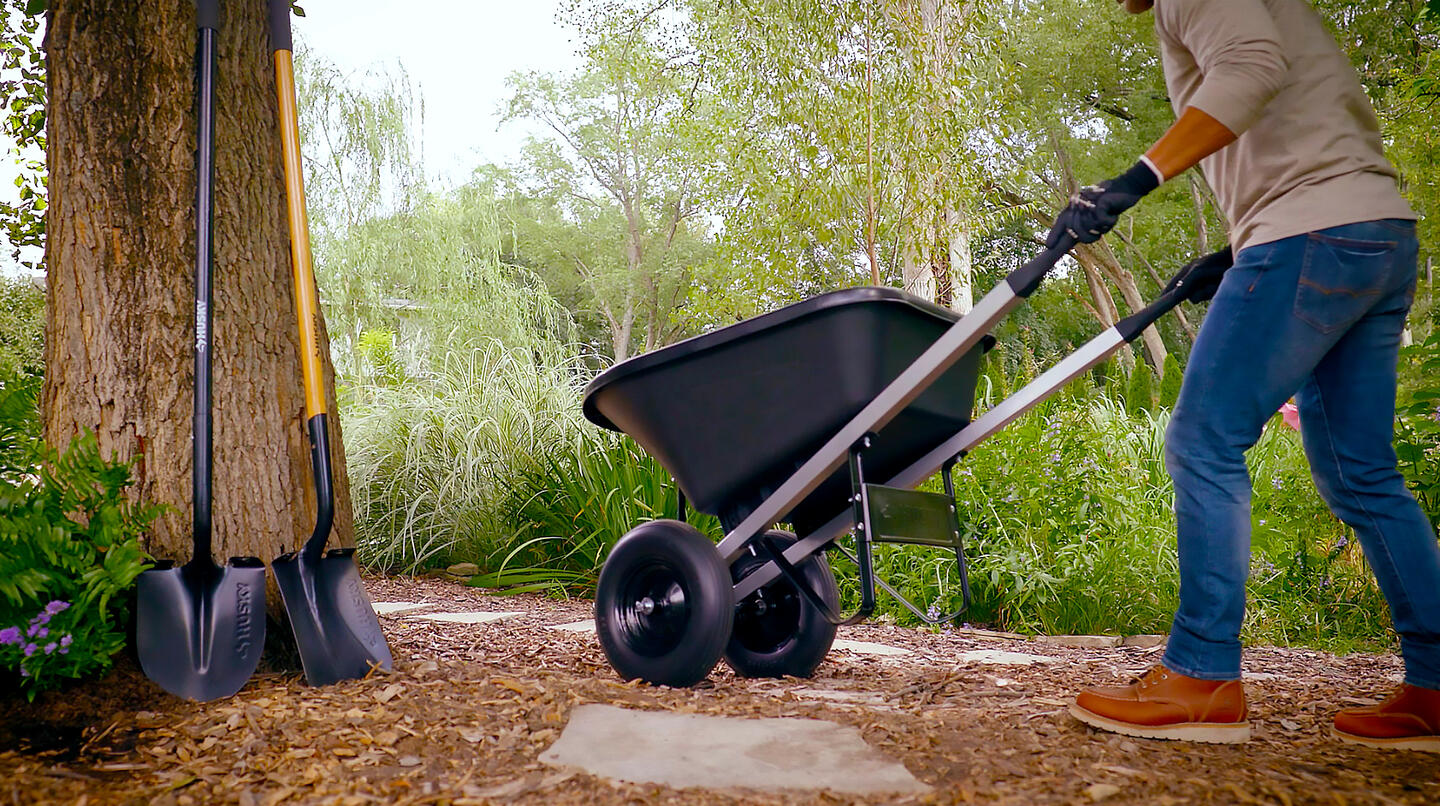)
Conclusion
In conclusion, a garden cart can be a great asset when it comes to tackling yard work. It allows you to easily transport large amounts of material with ease and comfort as well as give you extra storage space and organization. A good garden cart will serve you well in landscaping, gardening, or any other project that requires hauling material around the yard. Furthermore, these carts are versatile and can be used for many different tasks in the garden.
Whether you’re looking for an easy way to haul topsoil or mulch around your yard, or something more heavy-duty that can handle loads of whatever needs moving, there is sure to be an ideal garden cart perfect for your needs. Shop carefully when choosing one to make sure you select a high-quality model made with durable materials that will last for years of reliable use.
FAQ’S
What is the benefit of garden cart?
A garden cart can help make gardening tasks easier by providing a convenient way to transport tools, plants, and other materials around the yard.
What do you use a yard cart for?
A yard cart can be used for a variety of outdoor tasks, such as hauling dirt, mulch, plants, and tools.
What is a small cart used for carrying loads in the garden?
A small garden cart can be used for transporting smaller loads of tools, plants, or materials around the garden.
How can I make my yard work faster?
Some tips for making yard work faster include using the right tools for the job, organizing materials before starting work, and breaking larger tasks into smaller, manageable steps.
What are the benefits of utility cart?
A utility cart can be used for a variety of tasks, such as hauling tools, materials, or groceries, and can make it easier to transport items around the home or yard.
What is garden cart called?
A garden cart may also be referred to as a yard cart, utility cart, or wagon.
What are the benefits of garden tools?
Garden tools can help make gardening tasks easier and more efficient, allowing gardeners to work more comfortably and with greater precision.
What are 5 benefits of gardening?
Some benefits of gardening include physical exercise, stress relief, improved mental health, increased access to fresh produce, and the opportunity to connect with nature.
What is the benefits of gardening activities?
Gardening activities can provide a variety of benefits, such as improving physical and mental health, providing access to fresh produce, and helping to connect people with nature.
What are the 10 benefits of gardening?
Ten benefits of gardening may include physical exercise, stress relief, improved mental health, access to fresh produce, opportunities for creativity, improved air quality, connection with nature, social connection, learning opportunities, and a sense of accomplishment.
See Also-
- Best bag for push cart 2023
- Best garden cart 2023
- Best beach cart for soft sand 2023
- Best hand cart 2023
- Best yard cart 2023

